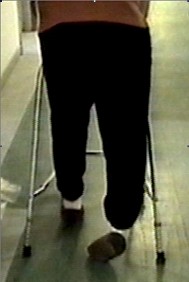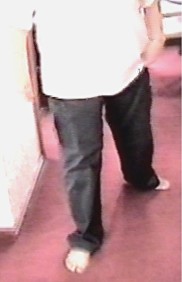A functional movement disorder means that there is abnormal movement or positioning of part of the body due to the nervous system not working properly (but not due to an underlying structural neurological condition that can be seen on a scan).
A variety of gait (walking) problems can occur as part of a functional disorder. As with all functional disorders, these do not occur because people walk like this on purpose. The movement and gait are involuntary.
In 2016 Miranda Licence, from Queensland, Australia, made a short film describing her experience with functional gait disorder with her uncle Jeff Licence, from ABC Open.
I’m really grateful to Miranda and Jeff for allowing me to share their story on this site.
This film tells you a lot about what it’s like to have a functional gait disorder and how treatment can help. Below that you can read more about different types of functional gait disorder and their treatment.
These are the most common types of functional gait disorder
One of the most common functional gait disorders is the ‘dragging’ gait seen in patients with functional weakness of one leg. You can read more about functional leg weakness here.


People with this kind of leg weakness find that the leg drags along the ground. It doesn’t often look as dramatic as this. The ankle is often turned in or out as in this picture. Some people feel like their foot is stuck to the ground almost like a magnet.
This is a problem called astasia. It means that the person has trouble standing still but can walk normally. It can be diagnosed by seeing if the problems standing go away when the person is distracted (for example playing a game on a phone or guessing some numbers written on their back).
The diagnosis of a functional gait disorder is usually made by a neurologist. It can be a difficult diagnosis to make because it requires expert knowledge of the full range of movement disorders due to neurological disease, many of which are unusual or even bizarre.
Even neurologists should be especially careful making a diagnosis of functional gait disorder. We know from studies that gait disorder is more commonly misdiagnosed as functional than other functional disorders.
But that doesn’t mean the diagnosis can’t be made.
Features that help with the diagnosis include:
Physiotherapy from someone who understands functional neurological disorders is the most important part of treatment.
Some of the things that may help may look a bit crazy when you see them written down. But they are all designed to help the brain regain ‘automatic’ movement in a situation where the normal pattern of movement has been “corrupted”.
This is a good example of why it’s important to have confidence in the diagnosis in order for treatment to help. If you thought that no one knew what was wrong it would be understandable that you might be reluctant to try the things listed below.


We will be re-directing you to the University of Edinburgh’s donate page, which enable donations in a secure manner on our behalf. We use donations for keeping the site running and further FND research.
